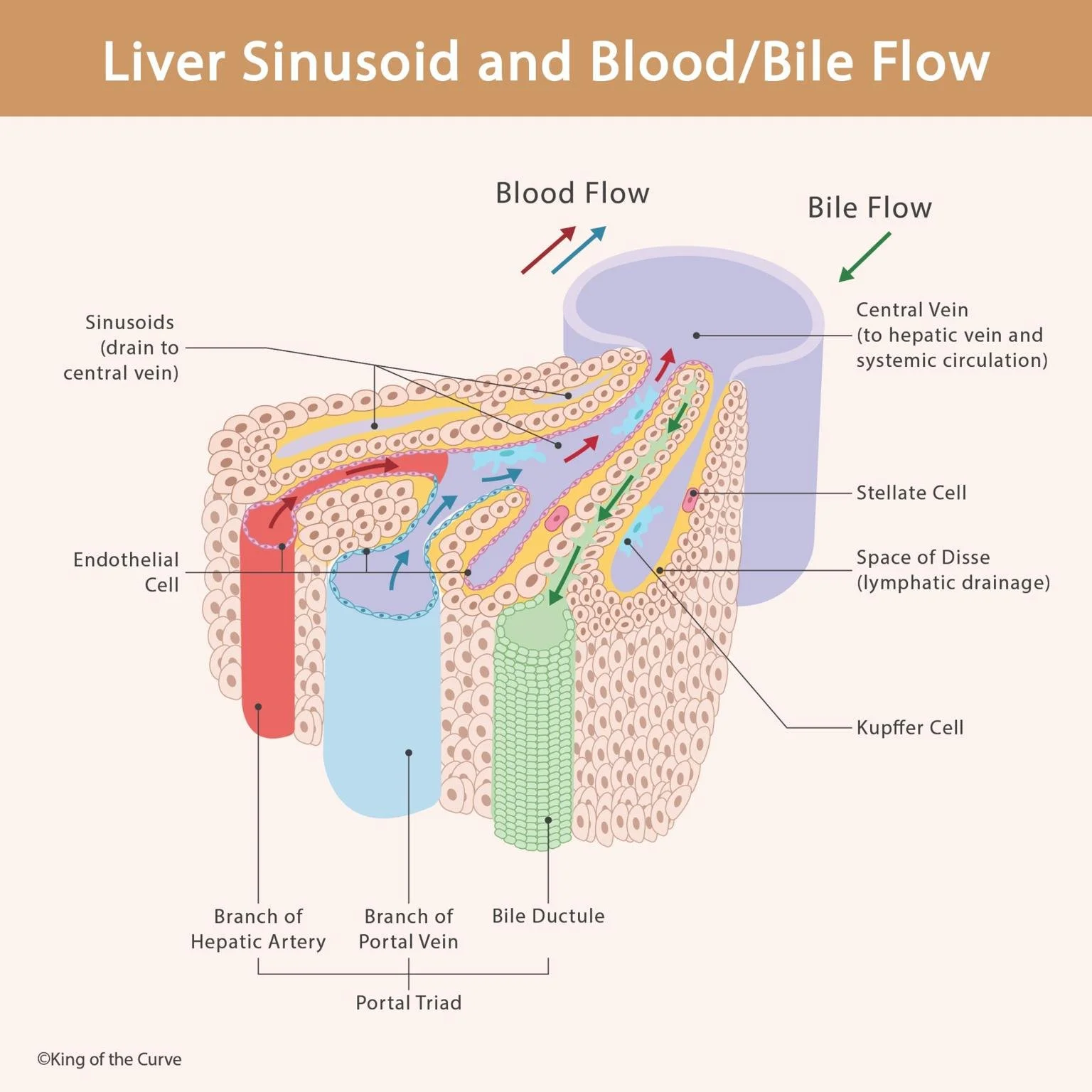🩸 Liver Sinusoid and Blood/Bile Flow
The liver is one of the most complex organs in the human body — a biochemical hub responsible for detoxification, nutrient processing, and bile production. But what makes it so efficient at multitasking? The answer lies within the microscopic network of liver sinusoids — specialized blood channels that connect the portal vein and hepatic artery to the central vein.
🧠 Understanding Liver Sinusoids
Sinusoids are fenestrated capillaries — meaning they have small pores that allow plasma to flow freely between the bloodstream and hepatocytes (liver cells). This plasma exchange happens within the Space of Disse, where vital nutrients and toxins are transferred for processing.
Blood from the hepatic artery (oxygen-rich) and portal vein (nutrient-rich) flows toward the central vein, while bile moves in the opposite direction toward the bile ductules — a perfect system of counterflow that ensures efficiency in every step.
⚙️ Flow Directions in the Liver
| Flow Type | Origin | Destination | Function |
|---|---|---|---|
| Blood Flow | Portal Triad (Hepatic Artery + Portal Vein) | Central Vein | Delivers oxygen and nutrients to hepatocytes |
| Bile Flow | Hepatocytes | Bile Ductules (within the Portal Triad) | Carries bile toward the gallbladder for fat digestion |
| Lymph Flow | Space of Disse | Lymphatic Vessels | Maintains fluid balance and drains excess plasma |
💡 KOTC Tip: Remember — blood and bile flow in opposite directions within the hepatic lobule. This counterflow design is a frequent question topic in MCAT-style passages.
🔬 Key Cellular Players
Kupffer Cells: Specialized macrophages that remove pathogens and debris.
Stellate (Ito) Cells: Store vitamin A and help repair tissue after injury, but can cause fibrosis if overactivated.
Endothelial Cells: Form the sinusoidal wall, allowing nutrient exchange.
Hepatocytes: The metabolic core — detoxifying, synthesizing, and secreting bile.
Together, these cell types maintain the liver’s delicate balance between filtration, metabolism, and regeneration.
🧩 Clinical Relevance: When the Flow Falters
When the sinusoids become scarred due to chronic liver disease or alcohol abuse, blood flow is obstructed. This leads to portal hypertension, impaired detoxification, and fluid buildup. Understanding this microanatomy helps future clinicians recognize how diseases like cirrhosis alter normal physiology at the cellular level.
This concept is frequently tested on exams like the MCAT, USMLE, and NCLEX, where students must connect anatomy to clinical reasoning. Knowing how blood, bile, and lymph interact provides a foundation for understanding hepatic pathology and pharmacokinetics (how drugs are metabolized).
🧬 The Bigger Picture: Integration Across Organ Systems
The liver doesn’t work in isolation — it’s deeply integrated with the digestive and circulatory systems. Blood from the GI tract delivers nutrients via the portal vein, while bile produced in the liver supports digestion by breaking down fats in the small intestine.
This dynamic interaction is essential for maintaining homeostasis and energy balance, which makes hepatic physiology a high-yield interdisciplinary topic across exams. Students who master this connection not only understand the liver but also strengthen their grasp of biochemistry and systemic regulation.
🚀 Call to Action: Learn Visually. Study Smarter. Stay Ahead.
At King of the Curve, we make learning effortless and rewarding through adaptive Q-banks, gamified learning tools, and 1,000+ high-yield science visuals — including liver physiology, hematology, and biochemistry.
Frequently Asked Questions (FAQs)
-
Aim for 4-6 focused hours, ensuring you incorporate breaks to avoid burnout.
-
Practice mindfulness techniques, take practice exams under realistic conditions, and maintain a balanced lifestyle.
-
Set short-term goals, seek support from mentors, and reward yourself for small achievements.
-
Regular exercise improves focus, reduces stress, and enhances overall mental clarity.
-
KOTC offers personalized learning tools, gamification features, and adaptive question banks to help students stay on track without burnout.


